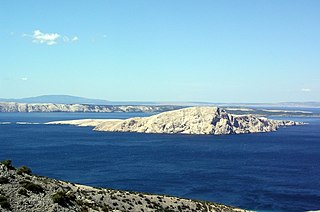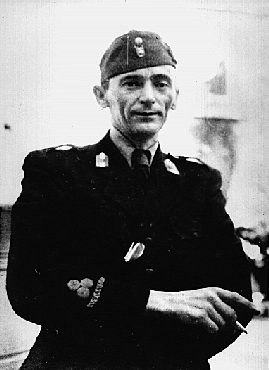
The Independent Democratic Serb Party is a social-democratic political party in Croatia representing the interests of the Croatian Serbs. It holds, progressive, pro-European stances and is generally considered a centre-left party.
The Croatian Revolutionary Brotherhood (CRB) (Croatian: Hrvatsko Revolucionarno Bratstvo or HRB), also known as Ustasha, was an Australian-based Croatian separatist terrorist organisation.

Goli Otok is a barren, uninhabited island that was the site of a political prison which was in use when Croatia was part of Yugoslavia. The prison was in operation between 1949 and 1989.

Jure Francetić was a Croatian Ustaša Commissioner for the Bosnia and Herzegovina regions of the Independent State of Croatia (NDH) during World War II, and commander of the 1st Ustaše Regiment of the Ustaše Militia, later known as the Black Legion. In both roles he was responsible for the massacre of Bosnian Serbs and Jews. A member of Ante Pavelić's inner circle, he was considered by many Ustaše as a possible successor to Pavelić as Poglavnik (leader) of the NDH. He died of wounds inflicted when he was captured by Partisans near Slunj in the Kordun region when his aircraft crash-landed there in late December 1942.

Blaž Nikola Kraljević was a Bosnian Croat paramilitary leader who commanded the Croatian Defence Forces (HOS) during the Bosnian War. An immigrant to Australia, Kraljević joined the Croatian Revolutionary Brotherhood (HRB) upon his arrival there in 1967. During his return to Yugoslavia in January 1992 he was appointed by Dobroslav Paraga, leader of the Croatian Party of Rights (HSP), as leader of the HOS in Bosnia and Herzegovina.

The Albanian National Army, is an Albanian paramilitary organization which operates in North Macedonia, Serbia and Kosovo. The group opposes the Ohrid Framework Agreement which ended the 2001 insurgency in Macedonia between members of the National Liberation Army and Macedonian security forces.
The Crusaders were a Croatian pro-Ustashe anti-communist guerrilla army. Their activities started after the capitulation of the Independent State of Croatia genocidal regime in May 1945, towards the end of World War II. The Crusaders' activities ended in 1950.

Slavko Goldstein was a Croatian historian, politician, and fiction writer.

Kerestinec concentration camp was a prison that served as a concentration camp in Kerestinec, Independent State of Croatia during World War II. It was located in a castle overlooking the village.

The Battle of Kupres was a battle of the Bosnian War, fought between the Army of the Republic of Bosnia and Herzegovina (ARBiH) and the Croatian Defence Council (HVO) on one side and the Army of Republika Srpska (VRS) on the other from 20 October to 3 November 1994. It marks the first tangible evidence of the Bosniak–Croat alliance set out in the Washington Agreement of March 1994, brokered by the United States to end the Croat–Bosniak War fought between the ARBiH and the HVO in Bosnia and Herzegovina. The ARBiH and the HVO were not coordinated at first, rather they launched separate operations aimed at capture of Kupres.

When World War II started, Zagreb was the capital of the newly formed autonomous Banovina of Croatia within the Kingdom of Yugoslavia, which remained neutral in the first years of the war. After the Invasion of Yugoslavia by Germany and Italy on 6 April 1941, German troops entered Zagreb on 10 April. On the same day, Slavko Kvaternik, a prominent member of the Ustaše movement, proclaimed the creation of the Independent State of Croatia (NDH), an Axis puppet state, with Zagreb as its capital. Ante Pavelić was proclaimed Poglavnik of the NDH and Zagreb became the center of the Main Ustaša Headquarters, the Government of the NDH, and other political and military institutions, as well as the police and intelligence services.
This article includes information on terrorist acts and groups in or against the Kingdom of Yugoslavia (1918–45) and Federal Yugoslavia (1945–92). Many of the terrorist acts were carried out outside Yugoslavia against Yugoslav subjects. The post-war period until circa 1985 was marked by frequent terrorist attacks on Yugoslav institutions organized by extremist emigrant organizations. Between 1962 and 1982, they carried out 128 terrorist attacks against Yugoslav civilian and military targets.
Operation Gvardijan was covert action of Yugoslav State Security Administration (UDBA) from 1947 and 1948. It prevented an attempt by Ustasha emigrants to carry out terrorist and diversionary actions in Yugoslavia and unite anti-communist Crusaders in the country, in an uprising against the new authorities.
The Battle of Bugojno was fought between forces of the Army of the Republic of Bosnia and Herzegovina (ARBiH) and the Croatian Defence Council (HVO) for control of the town and municipality of Bugojno in central Bosnia, from 18–28 July 1993. The area of Bugojno was under joint control of the ARBiH 307th Brigade and the HVO Eugen Kvaternik Brigade since the start of the Bosnian War. Violent incidents in Bugojno followed the escalation of the Croat-Bosniak War in adjacent municipalities throughout the 1st half of 1993. Bugojno was spared from fighting and the two local brigades were still formally allied by June 1993, at the time of an ARBiH offensive in central Bosnia.

The human rights record of Bosnia and Herzegovina has been criticised over a number of years by intergovernmental organisations including the United Nations Human Rights Council, the European Court of Human Rights and the Organisation for Security and Co-operation in Europe, as well as international and domestic non-governmental organisations such as Human Rights Watch and Amnesty International. The government of Bosnia and Herzegovina has been criticised for ethnic and religious discrimination in its treatment of ethnic and religious minorities such as the Romani people and the Jewish people. The government has also been criticised for its treatment of Internally Displaced Persons following the Bosnian War and its failure to provide asylum seekers with resources such as food, shelter and medical assistance. According to BH Novinari, the Bosnian Journalists’ Association, freedom of the media is an issue in Bosnia and Herzegovina, with journalists facing attacks, threats and pressure from government. Human rights non-government organisations have also reported interference in their work from the government. The Bosnian government has been criticised by the European Union for its slow response to domestically prosecute war crimes from the Bosnian War following the closure of the International Criminal Tribunal for the Former Yugoslavia in December 2017.
Centre for Nonviolent Action is a peace organization focused on building sustainable peace in the region of former Yugoslavia. It was founded in 1997 in Sarajevo, Bosnia and Herzegovina, and expanded to Belgrade, Serbia in 2001. The organisation's main objective is to promote nonviolence and dialogue through trust-building among people from the region as well as a constructive approach to dealing with the past.

At the end of World War II in 1945, members of the fascist Croatian ultranationalist and genocidal Ustaše regime from the collapsed Nazi puppet state of the Independent State of Croatia (NDH) fled from the Balkan region to avoid imprisonment and execution at the hands of the Yugoslav Partisans. With the help of Western authorities, who now viewed the fiercely anti-communist stance of the Ustaše favourably in the emerging Cold War, thousands of members of the regime were allowed to migrate to other countries, including Australia.

Srećko Blaž Rover was a member of the fascist, Croatian ultranationalist Ustaša movement. During World War II, he served as an officer in the Ustaše Surveillance Service and the Ustaše Militia where he was involved in the mass imprisonment and executions of people deemed enemies of the Independent State of Croatia. After the defeat of the Nazis and their collaborators, Rover escaped to Australia, where he became a leading figure of the Ustaše in Australia.











